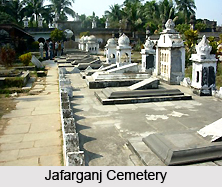 Murshidabad, the last capital city of independent Bengal was named after Nawab Murshid Quli Khan, the Dewan of Bengal, Bihar and Orissa. It is situated on the banks of the Bhagirathi. A city of splendors & famous for its silk, was made capital of Bengal in 1717. The British shifted the capital to Kolkata in 1773. Plassey, where the historic battle was fought in 1757 between Nawab Siraj-Ud-Daula and lord Clive, of East India Company, is only 40 Km. South of Murshidabad.
Murshidabad, the last capital city of independent Bengal was named after Nawab Murshid Quli Khan, the Dewan of Bengal, Bihar and Orissa. It is situated on the banks of the Bhagirathi. A city of splendors & famous for its silk, was made capital of Bengal in 1717. The British shifted the capital to Kolkata in 1773. Plassey, where the historic battle was fought in 1757 between Nawab Siraj-Ud-Daula and lord Clive, of East India Company, is only 40 Km. South of Murshidabad.
Murshidabad, a town resonating with history, a town of Nawabs and Dewans, a town on the edge of the battlegrounds of Plassey where the history of India changed course. Murshidabad is a town so steeply entrenched in history that you can almost hear the tinkle of bells on the feet of dancing girls, the clink of wine glasses, the swish of houseboats sailing down the Bhagirathi, the rumble of cannons and the thumping of feet running down the ramparts of the palace.
Imambara
Parallel to the north face of the Hazarduari Palace, stands the Nizamat Imambara, built in 1847 AD. by Nawab Nazim Mansoor Ali Khan Feradun Jah, son of Humayun Jah, at a cost of more than 6 lacs, after the Imambara built by Siraj-ud-Doula had been destroyed by fire. It took only eleven months to construct this Imambara. The Imambara, which is the largest in Bengal, is perhaps the largest in India.
Wasef Manzil
This Palace was built by Sir Wasef Ali Mirza, Nawab of Murshidabad. This beautiful Palace was also the residence of Nawab Wasef Ali Mirza. This palace is very near to the Hazarduari Palace and is near the South Gate. The staircases made of marble and beautiful statues of this Palace are worth seeing. The entry fee is Rupee 1 (Indian currency) for Indian nationals.
Katra Mosque
Katra Mosque is about one and a half km from Murshidabad Railway Station on the Berhampore-Lalgola Road. This imposing structure was built by Nawab Murshid Quli Khan in 1723-24 and it remains one of the most important tourist attractions. The gorgeous building with its huge domes and high minarets has a simple cemetery of the Nawab below the front staircase.

Jahan Kosha Cannon
Jahan Kosha, a huge cannon, is about 1 km of Katra. It was built in the early 17th century by craftsman Janardan Karmakar of Dhaka. Kadam Sarif is a beautiful mosque near Jahan Kosha said to contain a replica of the footprint of Hazrat Mohammad, the prophet. The canon is 17.5 ft long and weighs 16,880 lb., with a girth of 5 feet at the touch hole end. The diameter of the touch hole is one and a half inches, and that of the orifice is 6 inches.
Jafarganj Cemetery
About half a mile from the Hazarduari Palace is Jafarganj the ruined palace of Mir Jafar. The Cemetery contains the tombs of the Nawab`s Nazim, from Mir Jafar to Humayun Jah. Mir Jafar`s father Syud Ahmed Nazafi, Alivardi Khan`s sister, Shahkhanum, Mir Jafar`s widows, Munni Begam and Babbu Begam, Mohamed Ali Khan, the brother and Ismail Ali Khan and Asraf Ali Khan, the sons-in-law of Mir Jafar, lie buried here. This cemetery was built by Mir Jafar, over an area of 3.51 acres.
Khosh Bagh
Khosh Bagh lies on the opposite banks of Bhagirathi. The grave of Nawab Alivardi Khan, Alivardi`s Mother, Siraj-ud-Doula and his wife Lutfannesha and other members of the Nawab family lie here. The Khosh Bagh cemetery is built over 7.65 acres of land.
Katgola
Mahimapur is half a km North of the Nasipur Palace. Here, the palace of Jagat Seth and the once famous Pareshnath Temple are now in ruins.

Katgola, the palace garden of Raja Dhanpat Singh Dugar and Lakshmipat Singh Dugar and their famous Adinath Temple were built in 1873, by Harreck Chand. The walls of this temple are also intricately designed. A typically Jain style of ornamentation lends a unique beauty to this Jain temple. It is about half a km South-East of Mahimapur. Though some of its glory has been lost, it still remains a major tourist attraction, chiefly because of the beautiful temple with an admirable work of stucco.
Best time to Visit
The best time to visit Murshidabad is in winter, between October and April, when the weather is pleasant enough for you to spend the day sight seeing. Carry cotton clothes for the day and a light woollen in case it is cool at night. Mosquito repellent and sunscreen are always handy.
More on west Bengal
| Tribes of West Bengal | Bengali Theatre | Temples of West Bengal | Colleges of West Bengal |
| Tribal jewellery of West Bengal | Bengali Language | Districts of West Bengal | Medical colleges of West Bengal |
| Airports in West Bengal | Crafts of West Bengal | Cities of West Bengal | West Bengal Cricketers |
| Monuments of West Bengal | Bengali Wedding | Personalities of West Bengal | Bengali Literature |
| Folk Dances of West Bengal | Bengali Folktale | Museums of West Bengal | Bengali Newspapers |
| Festivals of West Bengal | Bengali Cinema | Universities of West Bengal | Places to See in West Bengal |



















